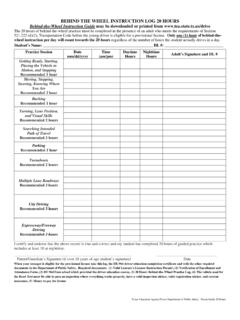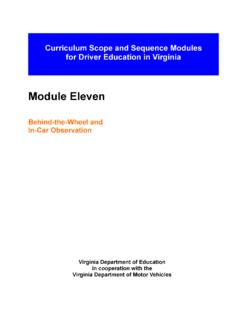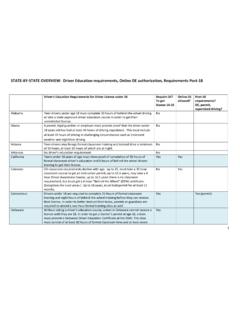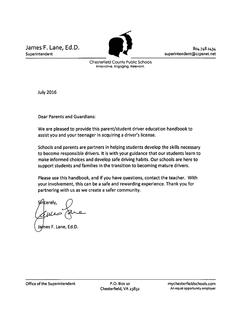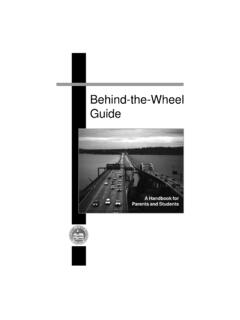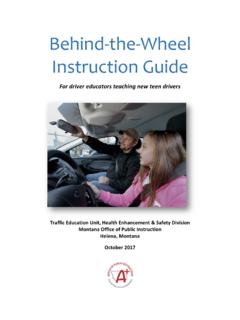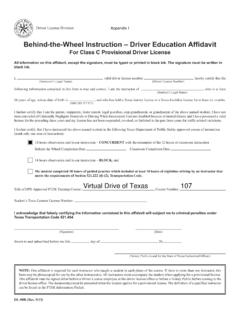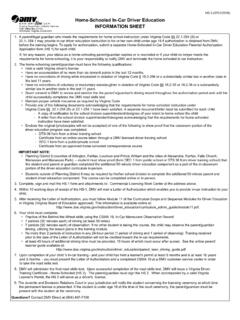Transcription of BEHIND THE WHEEL INSTRUCTION LOG 30 HOURS Behind …
1 BEHIND THE WHEEL INSTRUCTION LOG 30 HOURS BEHIND -the- WHEEL Instructi on Guide may be downloaded or printed from The 30 HOURS of BEHIND -the- WHEEL practice must be completed in the presence of an adult who meets the requirements of Section (d)(2), Transportation Code before the young driver is eligible for a provisional license. Only one (1) hour of BEHIND -the- WHEEL INSTRUCTION per day will count towards the 30 HOURS regardless of the number of HOURS the student actually drives in a Texas Education Agency/Texas Department of Public Safety Parent Guide 30 HOURS (rev 09/16/2013) Student s Name: DL #: Lesson time Practice Session Date Time (am/pm) Daytime HOURS Nighttime HOURS Adult s Signature and DL # 2 hour Getting Ready, Starting, Placing the Vehicle in Motion, Stopping 1 hour 1 hour 3 HOURS Moving, Stopping, Steering, Knowing Where You Are 1 hour 1 hour 1 hour 1 hour Backing 30 minutes 30 minutes 4 HOURS Turning, Lane Position.
2 And Visual Skills 1 hour 1 hour 1 hour 1 hour 3 HOURS Searching Intended Path of Travel 1 hour 1 hour 1 hour 1 hour Parking 30 minutes 30 minutes 2 HOURS Turnabouts 1 hour 1 hour 4 HOURS Multiple Lane Roadways 1 hour 1 hour 1 hour 1 hour 5 HOURS City Driving 1 hour 1 hour 1 hour 30 minutes 30 minutes 1 hour 5 HOURS Expressway/Freeway Driving 1 hour 1 hour 1 hour 30 minutes 30 minutes 1 hour TOTAL 20 HOURS minimum 10 HOURS minimum I certify and endorse that the above record is tr ue and co rrect and my student has complet ed 30 HOURS of guided practic e which includes at least 10 at nighttime. Parent/Guardian s Sig natu re (if over 18 years of age student s signature) Date When your teenager is eligible for the provisional license take this log, the DE-964 driver education completion certificate and with the other required documents to the Department of Public Safety.
3 Required documents: (1) Valid Learner s License ( INSTRUCTION Permit); (2) Verification of Enrollment and Attendance Form; (3) DE 964 or course completion certificate; (3) 30 HOURS BEHIND -the- WHEEL Practice Log; (4) The vehicle used for the Road Test must be able to pass an inspection where everything works properly, have a valid inspection sticker, valid registration sticker, and current insurance; (5) Money to pay for THE WHEEL INSTRUCTION LOG 30 HOURS BEHIND -the- WHEEL Instructi on Guide may be downloaded or printed from The 30 HOURS of BEHIND -the- WHEEL practice must be completed in the presence of an adult who meets the requirements of Section (d)(2), Transportation Code before the young driver is eligible for a provisional license. Only one (1) hour of BEHIND -the- WHEEL INSTRUCTION per day will count towards the 30 HOURS regardless of the number of HOURS the student actually drives in a Texas Education Agency/Texas Department of Public Safety Parent Guide 30 HOURS (rev 09/16/2013) Getting Ready, Starting, Placing the Vehicle in Motion, and St opping (p.)
4 14) Recommended 2 hour -- These practice sessions int roduce your teenager to the instrument panel, ve hi cl e control s, and mirror blind spots. The yo ung driver should get ready to drive, start the vehicl e, pl ace the vehicl e in motion, stop, and secure the ve hi cl e. Please review the vehicl e owner s manual be fore and during these practice sessions. Moving, Stopping, Steering, Knowing Where You Are (p. 15) Recommended 3 HOURS -- Focus on learning the correct procedures for movi ng, stopping , using reference poi nt s, and steering the vehicl e at different speeds. Begin in a large, level parking lot that is free of obstacles. The teenager should practice drivi ng around the perimeter of the lot at 10 and 15 mph. Using commentary drivi ng, have your teenager focus on smooth push-pull- slide hand-to- hand steering and stops. Your teenager should be taught to ease off the accel erator or use the brake to reduce speed before entering a curve and us e slight acceleration to ov ercome inertia an d pull the vehicl e out of the curve.
5 Ask the teenager to move the vehicle to specified tar gets in the parking lot at 10 an d 15 mph. The target is a fixed object that is located 12- 20 seconds ahead of the vehicl e, in the center of the pat h of travel, and is what the driver steers toward. It can be a car a block ahead, a traffic signal, the crest of a hill, etc. Havi ng a target helps the ne w driver to: vi sualize the space the vehicl e will be occupying; look far ah ead of the vehicl e an d begin a search to identify risks; improve steering accuracy. Focus on smooth acceleration, proper speed, and smooth stops. Explai n to your teenager that curling the toes back to ease pressure off the brake just before stopping results in smoother stops. Practice normal smooth stops and hard smooth stops whi ch are done at a slightly hi gher speed. Backing (p. 16) Recommended 1 hour -- Repeat the tasks lis ted in sessions Moving, Stopping, Steering, Knowing Where You Are with the vehicl e in reverse gear at idl e or slow speeds.
6 Backi ng from one target to anothe r allows your teenager to practice seeing, steering , and speed control skills with the vehicl e in reverse gear. Turning, Lane Position, and Visual Skills (p. 16) Recommended 4 HOURS -- During the next practice sessions practice 10 -15 right and left turns from stopped and moving positions in a parking lot . Left turns sho ul d be squared and right turns should be rounded. Emphasize proper signals, mirror checks, side- position reference point s, speed and steering control, and the need to look ahead of the vehicl e at a selected target in the center of the pat h of travel. Warn young drivers not to fixate on any one thi ng. Prior to progressing to drivi ng in a qui et neighborhood, your teenager should be able to demon strate the ability to move and stop the car smoothl y, mai nt ain a gi ven speed, and steer with reasonable precision. If your teenager is ready, practice right and left turns in a residential area.
7 Searching Intended Pat h of Travel (p. 18) Recommended 3 HOURS -- In a residential area, or , if ready, on roads with light traffic, continue working on basic vi sual skills, negotiating curves, an d right and left turns. Practice judging space in seconds, identifying a target, and searching the target area and target path. Ask your teenage r to comment prior to changi ng speed or position. Young drivers have the tendency to monitor the road immediatel y in front of the vehicl e. Parking (p. 19) Recommended 1 hour -- Angle Parking, Perpendicular Parking, Parallel Parking, Curb Parking, Parking Uphill, Parking Downhill Turnabouts (p. 21) Recommended 2 HOURS -- Focus on recognizi ng the di fferent types of turnabout s and selecting the appropriat e type of turnabout for a gi ven situation. Begin in a large, level parking lot free of obstacles. Practice 2- point , 3- point , and U-turns in a parking lot . Progress to a lightly traveled residential area, and practice vi sual search skills, turns , and each turnabout at least 10 times.
8 The easiest and safest way to change di rections is to drive around the bl ock. Multiple Lane Roadways (p. 22) Recommended 4 HOURS -- Focus on lane position, lane changing, following distance, and mirror blind spots. If possibl e, choose a time when the four -lane roadway on whi ch you select to practice has minimal traffic, such as during early morning HOURS on Satur day or Sunday. There are several lane position choices a driver can make without changing lanes. Practice drivi ng in lan e position 1, 2, a nd 3 for several miles during each session. City Drivi ng (p. 24) Recommended 5 HOURS -- Focus on drivi ng on crowded urban roadways. During the se practice sessions have your teenager examine the importance of scanning ahead, lane position, covering the brake, and the hazards associat ed with parked cars, traffic congestion, and di stractions. Deci sion- making is the most important skill used in drivi ng . A driver operating in city traffic flow makes 50-60 decisions per mile.
9 Drivers need visibility, space, time, and adequate traction to perform all maneuvers in city traffic whether crossing, tur ning, passing, or adjusting speed and/or position. During these sessions ask your teenager to focus on controlling space to the front and speed to en hance vi sibility, space, time, and traction. Drivi ng on congested roadways allows a very small margin for driver error. Effective searching skills and driver alertness are both essential. Every second counts in thi s driving environment. Expressway/Freeway Drivi ng (p. 25) Recommended 5 HOURS -- Focus on compl ex risk drivi ng environments at speeds up to 70 mph. Traffic flow on expressways can be heavy and at times unpredict able. They are called limited access highways because there are only certai n locations, called int erchanges, where a driver ca n enter and exi t the expressway. Expressways have a low frequency of collisions, but often have hi gh injury severity rates when a collision does occur because of the hi gher speeds.
10 Review the expressway information in the Texas Driver Handbook. Make sure your teenager underst ands the di fferent kinds of expressway int er changes, expressway signs, signals, lane markings, speed limits, and the importance of mai nt aini ng a 20-30 second vi sual lead.
